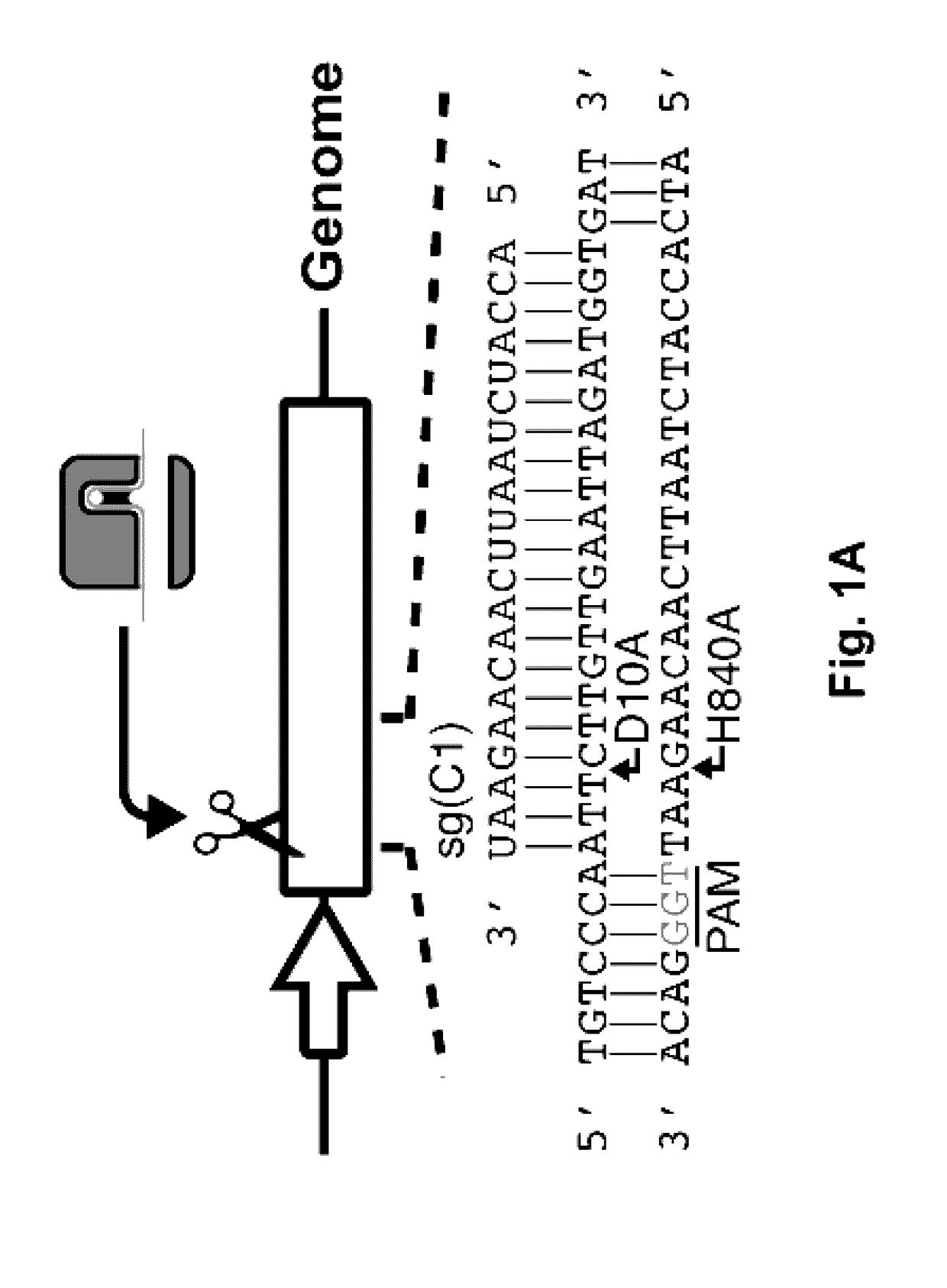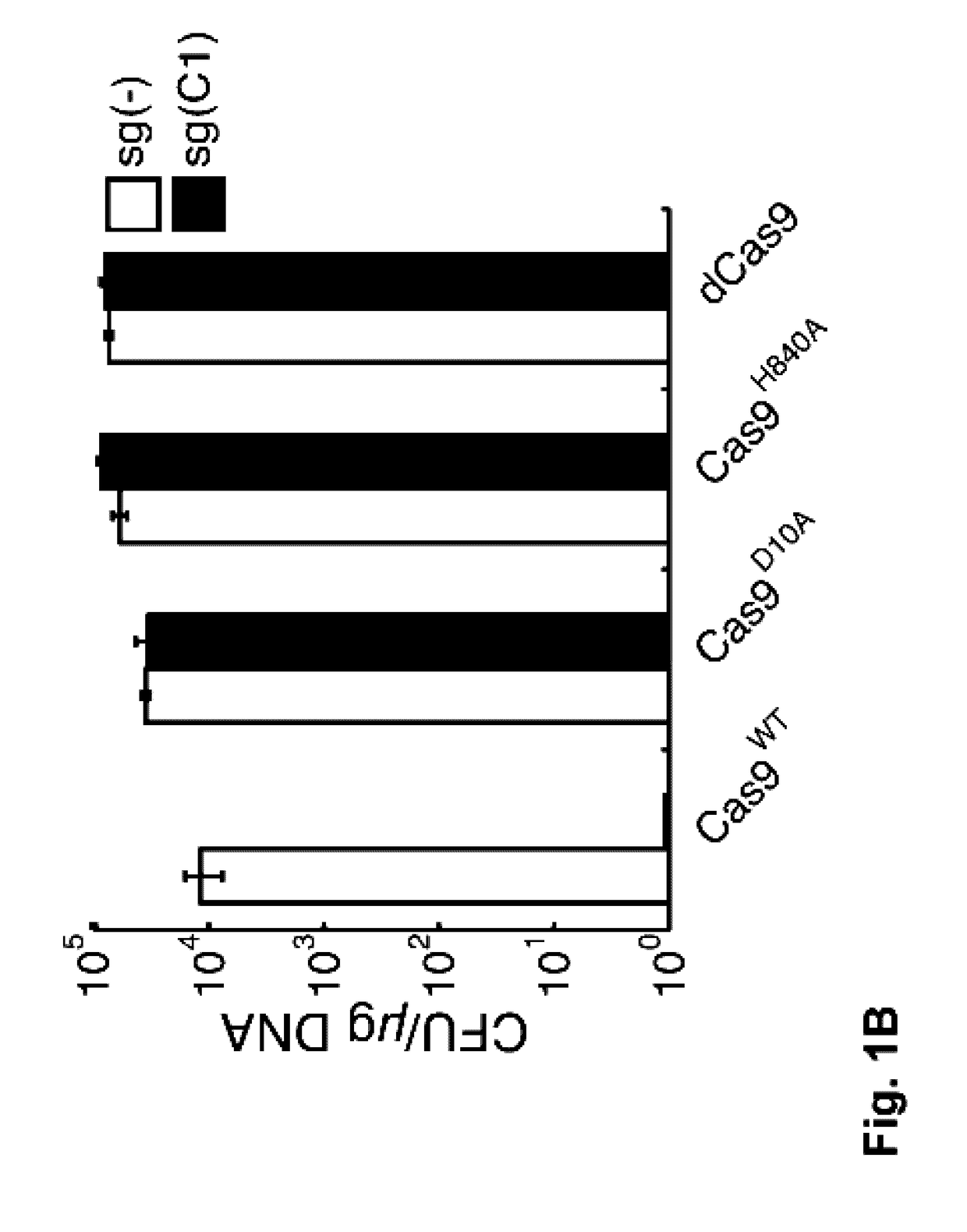Targeted remodeling of prokaryotic genomes using crispr-nickases
a genome remodeling and prokaryotic technology, applied in the field of prokaryotic genome remodeling, can solve the problems of inability to produce desired genotypes in the lab, lack of efficient methods for large-scale genome remodeling of bacterial genome remodeling technology, and lack of dna-targeted dna-targeted dna-targeted sequences
- Summary
- Abstract
- Description
- Claims
- Application Information
AI Technical Summary
Benefits of technology
Problems solved by technology
Method used
Image
Examples
example 1
Generation the CRISPR-Cas9 System of the Present Invention
1. Strain and Media
[0051]Molecular cloning was conducted using E. coli NEB-10-Beta (New England Biolabs, NEB). Maintenance and cloning of vectors containing an R6Kγ origin of replication was conducted in DH5a (Pir+). Fluorescent reporter experiments were conducted in K12 MG1655 (ΔLacIΔAraC) HK022 (J04450 and / or 113522) (Registry of Standard Biological Parts). Initial 36 kilobase (kb) deletion experiments were conducted in K12 MG1655 (ΔLacIΔAraC). Experiments involving the 97 kb deletion were conducted in K12 MG1655 (American Type Culture Collection, ATCC, #700926) HK022 (topA, cysB, ribA, fabI), 186 (lapAB). Integrations into HK022 attB and 186 attB sites are described in strain construction section. LB Miller Medium (Sigma Aldrich, Sigma) was supplemented with appropriate antibiotics for plasmid maintenance: ampicillin (100 μg / ml) and / or kanamycin (30 μg / ml). Experiments involving fluorescent microscopy visualization of geno...
example 2
CRISPR-Directed Single Stranded DNA Breaks are not Lethal to Prokaryotes
[0064]To experimentally assess the lethality of CRISPR-directed SSBs in wild type E. coli, we constructed a two-plasmid system (FIG. 6A): one plasmid expresses Cas9 and another expresses an sgRNA against a genome integrated green fluorescent protein (GFP) gene (FIG. 1A). Multiple mutant versions of Cas9, including Cas9D10A, Cas9H840A, and a Cas9D10A, H840A double mutant (29), were tested. The D10A mutation abrogates function of the RuvCI nuclease domain, generating a Cas9 capable of only nicking the DNA strand complimentary to the sgRNA. On the other hand, the H840A mutation removes function of the HNH nuclease domain resulting in a Cas9 that cleaves only the non-complimentary strand to the sgRNA (FIG. 1A) (29). Combination of both D10A and H840A leaves Cas9 catalytically dead (dCas9) (32). Therefore, dCas9 can only bind to target DNA without any cleavage of the chromosome.
[0065]We transformed GFP targeting sgRN...
example 3
Genome Deletion in Prokaryotes Using the CRISPR-Cas9 System of the Invention
1. Proof of Principle
[0066]Although it has been reported that HR could be an inconvenience in building synthetic gene circuits with repetitive parts (33), a precise nick between repeat sequences could hypothetically induce rationally designed HR to achieve targeted genome deletion (34). To explore the potential of using CRISPR generated nicking to induce targeted HR, we constructed a genome integrated synthetic dual-reporter system (FIG. 2A) to query gene deletion and viability. In this system, GFP was designed to be flanked by two 129 base pair direct repeats (R). We systematically targeted nicking sites between direct repeats to both strands of GFP with Cas9D10A and Cas9H840A. The fluorescent population distributions of sgRNA(T1) Cas9D10A indicate that GFP is phenotypically lost in 86% of the cells (FIG. 2B, outlined). This target site is about 110 bp away from the left repeat.
[0067]To verify HR as the cau...
PUM
| Property | Measurement | Unit |
|---|---|---|
| concentration | aaaaa | aaaaa |
| temperature | aaaaa | aaaaa |
| temperature | aaaaa | aaaaa |
Abstract
Description
Claims
Application Information
 Login to View More
Login to View More - R&D
- Intellectual Property
- Life Sciences
- Materials
- Tech Scout
- Unparalleled Data Quality
- Higher Quality Content
- 60% Fewer Hallucinations
Browse by: Latest US Patents, China's latest patents, Technical Efficacy Thesaurus, Application Domain, Technology Topic, Popular Technical Reports.
© 2025 PatSnap. All rights reserved.Legal|Privacy policy|Modern Slavery Act Transparency Statement|Sitemap|About US| Contact US: help@patsnap.com



